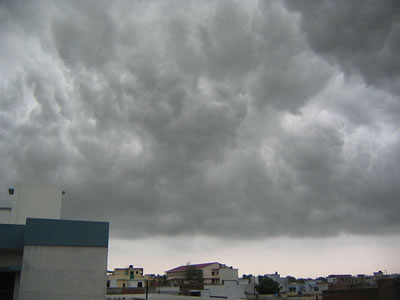A monsoon is a pattern of wind and rain that changes direction seasonally. Monsoons occur because water heats up and cools down more slowly than land does.
When the temperature starts to become warm, the air over the land heats up more quickly than the air over the ocean. Cooler air has a higher pressure than warmer air, so the air over the ocean has a higher pressure than the air over the land. Because air flows from a region of higher pressure to a region of lower pressure, the air over the ocean blows over the land, bringing rain.
When the temperature cools, the opposite occurs. The land cools faster than the ocean does, so the air over the land now has a higher pressure than the air over the ocean. Therefore, the wind blows from the land to the ocean.
Often, people use the word “monsoon” to refer to the heavy rains that come during the warmer part of the year in monsoon regions.
When we think of a monsoon, we often think of the Indian subcontinent. In fact, the term was first used to describe the weather pattern that exists there. However, monsoons occur all over the world, including the southwestern United States and Mexico, sub-Saharan Africa, northern Australia and Indonesia, and East Asia.
Monsoons have a profound effect on people who live in the regions where they occur. In drier climates, monsoon rains bring much needed precipitation, ending droughts. In wetter climates, heavy rains brought by monsoon winds can cause dangerous floods.
Inhabitants of lands that experience monsoons tend to depend on them for agriculture. If the rains do not come as expected, people may go hungry. Agricultural businesses will suffer.
In India, hydroelectric plants run on water from the monsoon rains. When there is not enough rain, electricity becomes very expensive.
When monsoon rains in India have become too heavy, however, flooding has caused many deaths.
In the southwestern US, the summer monsoon helps prevent wildfires by adding moisture to the air.
Climate Change and Monsoons
Because monsoons play such an important role in the lives of people all over the world, scientists are studying how monsoons will be affected by climate change.
In a paper published in Environmental Research Letters in November 2012, Jacob Schewe and Anders Levermann of the Potsdam Institute for Climate Impact Research reported that, according to a computer simulation, global warming caused by human activity would decrease summer monsoon circulation in the northern hemisphere and, consequently, cause India’s summer monsoon rains to fail more frequently over the next 200 years.
However, earlier this year Professor Bin Wang of the University of Hawaii and his colleagues reported, in a study recently published in the Proceedings of the National Academy of Sciences, the summer monsoon circulation has, in fact, intensified over the past three decades, and the amount of summer monsoon rainfall has increased much more than predicted, despite average global temperature increasing by about 0.4 degrees Celsius during that time. This intensification was caused mostly by predicted long-term oscillations in ocean temperature: the Interdecadal Pacific Oscillation and the Atlantic Multidecadal Oscillation.
